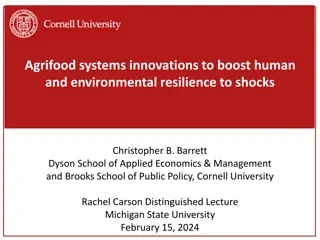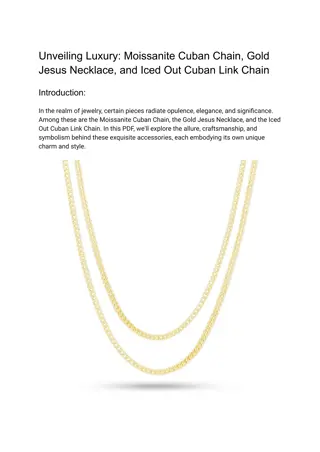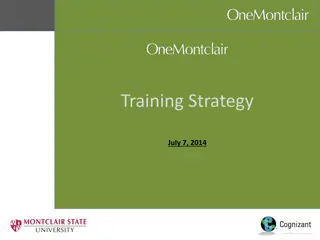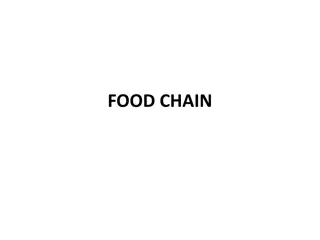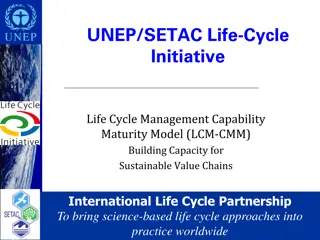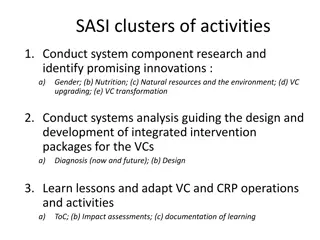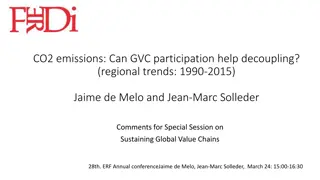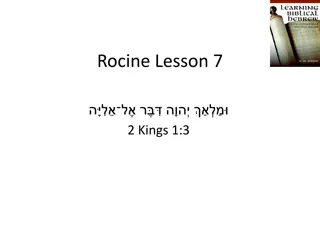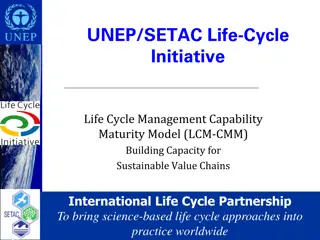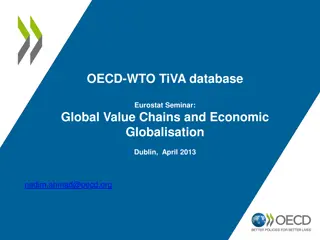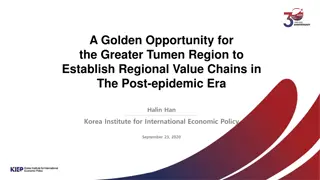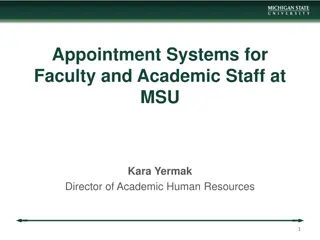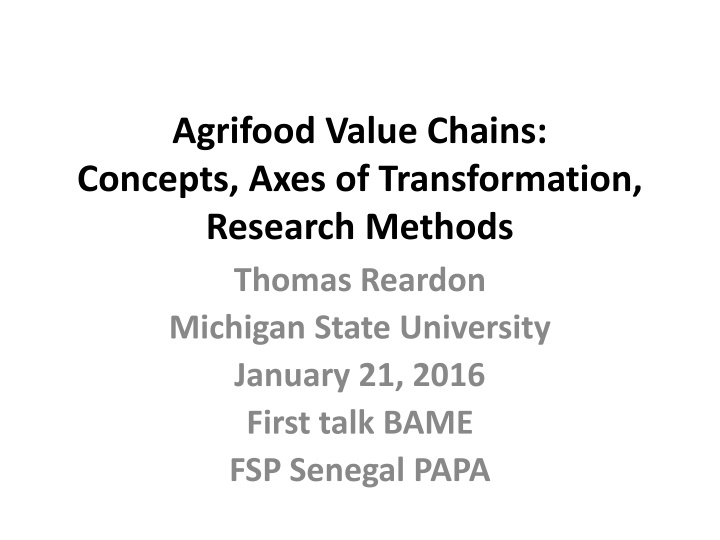
Value Chains Transformation Research Methods & Concepts
Gain insights into agrifood value chains transformation, research methods, and concepts outlined in a talk by Thomas Reardon at Michigan State University. Explore concepts like VC typology, policy issues, and empirical approaches for hypothesis testing. Dive into research questions on structural change, geographical impact, and socioeconomic distribution within value chains.
Download Presentation

Please find below an Image/Link to download the presentation.
The content on the website is provided AS IS for your information and personal use only. It may not be sold, licensed, or shared on other websites without obtaining consent from the author. If you encounter any issues during the download, it is possible that the publisher has removed the file from their server.
You are allowed to download the files provided on this website for personal or commercial use, subject to the condition that they are used lawfully. All files are the property of their respective owners.
The content on the website is provided AS IS for your information and personal use only. It may not be sold, licensed, or shared on other websites without obtaining consent from the author.
E N D
Presentation Transcript
Agrifood Value Chains: Concepts, Axes of Transformation, Research Methods Thomas Reardon Michigan State University January 21, 2016 First talk BAME FSP Senegal PAPA
Overview of Talk 1) Concept of the Value Chain (VC), fish image 2) Axes of VC transformation: structure, conduct/behavior 3) VC typology based on structure & conduct 4) Context of VC transformation: conditioners/drivers 5) Axes of VC transformation: performance 6) Linking policy issues & research questions/hypotheses 7) Empirical approach to hypothesis testing: survey sampling and questionnaires, analysis
1. VC concept Picture a fish in your mind.
a) VC composed of principal spine of segments b) Each segment of which supplied by input VCs c) Policy issues linked to both of the above example from Bangladesh
1. Research Questions: patterns, determinants, effects a) The study focuses on the structure-conduct- performance of the VCs: BY SEGMENT AND OVER SEGMENTS in a snapshot view of patterns & determinants and a dynamic view of transformation b) What are the patterns & determinants in the structure of the segments of the VCs and the dynamics of restructuring? geography: what is the map of the flows of product between rural production areas and cities and towns? How has this changed over time and why? 5
structure and structural change: what are the patterns, determinants, and (over time) processes of consolidation (or de-concentration) and diffusion taking place in each segment socioeconomic distribution: are the poor and small-scale actors participating in the segments, and how is this changing over time and over clusters 6
b) Conduct Technology patterns and change: What are the patterns and determinants of technology, scale, and variety change? Is there capital intensification? What are the threshold investments needed to make the technology changes? Marketing patterns and change: Is there and how much of a shift from marginal/backyard to commercial producer , and among commercial producers, the shift over market channels or choice of trader type? Is dis-intermediation observed? 7
Institutional and organizational arrangements conduct: What are the patterns and determinants in adoption of safety standards, quality assurance regimes, and cooperative/collective input or output marketing arrangements? What coordination and governance mechanisms are used and how do they vary by segment and VC type? Food Safety practice conduct: What are the patterns and determinants in use of cold chain and chemical additives? Utilization/consumption patterns of consumers 8
c) Performance Equity: What is the participation of the poor and women in the value chain segments? What is the employment impact of the VC transformations observed? Distribution of gains: How is value added distributed over the actors in the segments of the VC? Efficiency: What is the allocative and technical efficiency of the different segments and VC types, and how does this vary over products, clusters, and time? How does this impact competitiveness and the product price to consumers? 9
Safety: What is the impact on food safety and the environment of the practices observed in the value chain 10
2. LINK between policy shocks & VC analysis a) All patterns (structure & conduct) in segments and over segments driven by actors choices b) All choices are function of two sets of (proximate) drivers: incentives and capacity c) Incentives & capacity In turn affected by c.1) Non policy variables c.2.) Policy variables (ex. Road, energy cost, tax) 11
d) Per segment need sufficient variation over time & over actors to test hypotheses regular sample survey per segment (not small sample key informant) . Stacked surveys VC approach 12
3. (Evolution of) VC Analysis perspectives 3.1. Traditional: typology plus mapping cost and value added and costs across segments, space, actors; link to PAM 3.2. VC Management: Porter, commodity/ engineering SC to VC (product cycle & standards/attributes evolution) example (is 3.1. but differentiation by type of given product)
3.3. NIE: choice of institutions & organizational forms as coordinating mechanisms; function of TCs Micro: choice of mechanisms by actors (e.g.) Meso evolution of A-system (spot), B-System (spot or VI/hierarchy) or C-system (VI/hierarchy or networks) EXTENSION: Global VC power relations Lead Firm + standard/VA (rents) + choice of coordination mechanism (link to NIE) rent (profits) distribution along VC segments (and intra-segment strata)
3.4. Network/netchain analysis: clustering/de- clustering, networks/functional fragmentation and flexible specialization study of formation of clusters & inter-actor relations (conditioners) 3.5.a. Per segment (and over scales hence inter- actor differentiation) micro and meso determinants and evolution: analysis of micro a) technology choice, b) market channel choice, c) procurement system choice
3.5.b. Upgrading as Investment functions bundling technology + VA/attribute choices i) (Micro)Investment function ii. (Meso) investment function iii. Links of upgrading in VCs with investment functions (and poverty traps, or kinks in investment functions) and links back to micro and meso constraints)
3.5a. And 3.5b (micro)_ aggregate to meso structure/conduct/performance study shocks of policy change, non policy change via those to test and explain change via micro foundations inter-actor inter-temporal
4. Structure & Conduct/Behavior based typology of VCs as broad patterns of meso: 4.1.a. Columns as typology of VCs a) A-System (local/traditional and traditional rural-urban VC) b) B-system (transitional rural-urban VC) c) C-system (modern rural urban and international VC) d) SUB COLUMNS are segments of VC and overall
4.1.b. VC typology based on structure (example on board with Bangladesh fish) a) Most traditional with spatially short, intermediationally short b) Traditional with spatially longer, intermediationally long c) Intermediate/transition with initial dis- intermediation with initial structural & conduct transformation d) Modern with re-intermediation & advanced disintermediation with advanced transformation
4.2. row sets for mapping of attributes and findings 4.2.1. Commercial orientation, distribution of VA & leadership a) spatially: short to long b) Product Cycle/VA: niche to commodity to differentiated (commercial) product c) Product composition: types of product linked to product cycle
d) Lead Firm (a la Gereffi): upstream or midstream or downstream led e) Distribution of VA over segments and over sub-strata in segment: upstream to downstream, socioeconomic; also structural: Share of post-farmgate small to large f) Capital ownership: domestic to regional to global; investment dynamics
4.2.2. Structural a) Geographic length: short to long b) Intermediational length: monotonic: many hands to few hands/direct sale/direct buy (or U or J curve); Tanzania maize vs hortic. c) Share of post farmgate in total VA d) Per segment consolidation: fragmented to consolidated e) Netchain/network/clustering: no cluster, clustered, de-clustered, networked clusters
4.2.3. Conduct: Technological a) Scale of firm: from small to big b) Capital/labor ratio of firms: from low to high (and vintage & type change: hammer to roller mill) c) Asset specificity: from low to high d) Labor skill: from low to high e) Productive capital attributes (transferred vs indigenous etc.)
4.2.4. Institutional & Organizational a) Market organization: spot to coordinated to VI b) Vertical integration (or functional fragmentation ): fragmented to linked c) Horizontal integration: individual to horizontal linkage (coops, clusters) d) Procurement system change by buying firms: distribution centers/centralized, & specialized/dedicated wholesalers/agents
e) Inter-firm institution/contracts: spot to contracts (verbal to written) f) inter-segment VC finance (tied, not tied) g) Inter-segment institution/standards existence, setter, and type (e.g. public standards; vs Globalgap horticulture product standards) h) Diffusion of brands (plus packaging)
4.3. Axes of VC transformation: performance (changes) a) Value added distribution over segments (example of quality rice in Bangladesh) b) Distribution of participation: Exclusion and inclusion by asset or zone c) Variability/risk of supply and prices d) Income and employment impact on producers (upstream and midstream) e) Price/access and nutrition impacts on consumers
Illustrations of descriptive information 5. a) Overview of tables in book 5.b.) overview tables in potato and rice India


